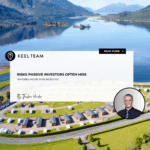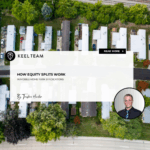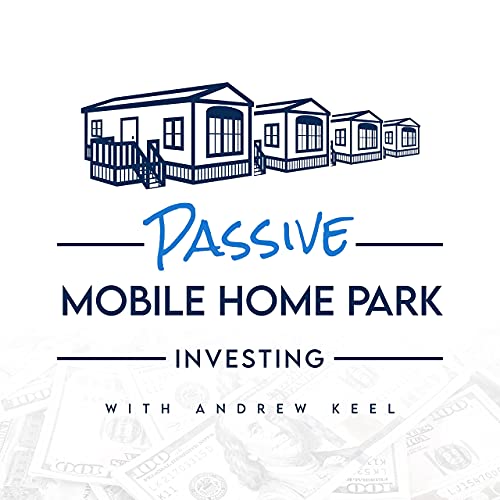Mobile Home Parks Have Attractive Financing Options
-
 Andrew Keel
Andrew Keel
Listen on Apple Podcast here: https://podcasts.apple.com/us/podcast/mobile-home-parks-have-attractive-financing-options/id1520681893?i=1000487782185
SHOW NOTES
Welcome back to the Passive Mobile Home Park Investing Podcast, hosted by Andrew Keel. Some of the nation’s largest lenders are actively lending money in the Mobile Home Park space. On this episode of the Passive Mobile Home Park Investing Podcast, Andrew talks about reason #10 for investing in trailer parks: mobile home park’s have attractive financing options whether for an acquisition or a refinance. Typically, in current times, when financing a mobile home park acquisition the loan-to-value one can expect is between 70-80%, meaning that the purchaser is required to bring a down payment of only around 20% to 30%.
Andrew Keel is the owner of Keel Team, LLC, a Top 100 Owner of Manufactured Housing Communities with over 1,300 lots under management. His team currently manages over 20 manufactured housing communities across nine states – AR, IA, IL, IN, MN, NE, OH, PA and TN. His expertise is in turning around under-managed manufactured housing communities by utilizing proven systems to maximize the occupancy while reducing operating costs. He specializes in bringing in homes to fill vacant lots, implementing utility bill back programs, and improving overall management and operating efficiencies, all of which significantly boost the asset value and net operating income of the communities.
Andrew has been featured on some of the Top Podcasts in the manufactured housing space, click here to listen to his most recent interviews:https://www.keelteam.com/podcast-links.
In order to successfully implement his management strategy Andrew’s team usually moves on location during the first several months of ownership. Find out more about Andrew’s story at AndrewKeel.com.
Would you like the pre-investment checklist that I use to review mobile home park deals before I invest in them? We are offering this as a free gift if you go to iTunes and leave a five-star review. To get the pre-investment checklist, leave us a five-star review on iTunes and then send us an email at passivemhpinvesting@gmail.com. In the email, please tell us who you are, what screen name you used to leave that review, and we’ll send the pre-investment checklist, directly to your inbox.
Talking Points:
00:20 – Welcome back to the Passive Mobile Home Park Investing Podcast
02:36 – Non-recourse debt
04:20 – The Debt Service Coverage Ratio
05:12 – In conclusion
05:25 – The pre-investment checklist
SUBSCRIBE TO PASSIVE MOBILE HOME PARK INVESTING PODCAST YOUTUBE CHANNEL https://www.youtube.com/channel/UCy9uI3KGQmFgABsr9lUtRTQ
Links & Mentions from This Episode:
Keel Team’s Official Website: https://www.keelteam.com/
Andrew Keel’s Official Website: https://www.andrewkeel.com/
Andrew Keel LinkedIn: https://www.linkedin.com/in/andrewkeel
Andrew Keel Facebook Page: https://www.facebook.com/PassiveMHPin…
Andrew Keel Instagram Page: https://www.instagram.com/passivemhpi…
Twitter: @MHPinvestors
TRANSCRIPT
Welcome to The Passive Mobile Home Park Investing Podcast with your host, Andrew Keel. This is the podcast where you can get the education you need to invest 100% passively in a highly profitable niche of mobile home parks.
Welcome back to the Passive Mobile Home Park Investing Podcast. This is your host, Andrew Keel, and today, we are going to discuss reason number 10 why should invest in mobile home parks. The 10th reason is because there are attractive financing options currently available for the acquisition and refinancing of manufactured housing communities. Fannie Mae, Freddie Mac, CMBS, and others currently lend in the space.
This leverage assists in the boosting of returns for passive investors. As of this recording in 2020, typical financing on mobile home parks that one can expect is around a 70%-80% loaned value meaning the purchaser is required to bring a down payment of only 30%-40% The typical amortization period is around 20-30 years. It’s important to know there are interest-only options available as well from some of the larger nationwide lenders, but the property must qualify and be a certain level for those.
Operators can typically fix an interest rate for a time period of around 5-10 years. And the typical interest rate, as of this recording, is currently around 3%-5%, which is historically low. Prepayment penalties will usually apply with all financing options, whether an operator chooses to go with a local bank or a large nationwide lender. Different sized communities will allow for different financing options. Usually, the bigger the community, the better the debt. It will be able to ultimately secure.
Also, having a higher property class grade will ultimately open better financing doors. For example, an A grade, 55 and older, fully occupied mobile home community in Sarasota, Florida with around 200 lots and amenities such as a swimming pool, a par-3 golf course, and a community room will usually be able to qualify for the best financing available, which currently would be with the agencies Freddie Mac and Fannie Mae.
This debt would be non-recourse, which is huge, meaning the only collateral for the loan would be the real estate itself. This type of community could expect to get around an 80% loaned value, usually three years or more of interest-only payments, and a 30-year amortization after that. This type of property will usually be able to get around a 10-15 year fixed interest as well. The interest rates for this type of community would be the best available, which currently is around 2%-3%. Talk about some good financing terms.
On the opposite end of the spectrum, a D-grade old, age mobile home community that is 50% occupied in Indiana with 50 lots or more, they would likely have to get bank financing, a local bank to finance the purchase of the property. And this would require recourse debt, which is debt that is backed by collateral from the borrower and not just by the real estate itself.
Terms that could be expected would be around a 60%-70% loan to value, a 15-20 year amortization, a fixed rate of around 5 years, and an interest rate of around 4%-5%, which is still really good.
On some fixer-upper value add deals like this, the local banks can require operators to hold their operating accounts with the capital expenditure funds in it at the bank after closing. The bank can then require invoices or photos to show proof of improvement to release the capital expenditure funds to the operators.
The debt service coverage ratio or DSCR, which is the net operating income divided by the total debt service that most banks look for is around 1.25 and above. This ultimately means that the income a property generates will need to be able to cover the debt payments even if it is reduced by 25%.
In conclusion, there are a variety of different financing options available to operators of mobile home parks. Partnering with an operator that has a good network of financing connections is uber important for the long term success of an investment. Overall, having this many financing options available is a positive note to investing in mobile home parks.
That’s it for today. We’ll see you next week when we discuss the reasons why mobile home parks are recession and inflation resistant. Thank you so much for tuning in.
Would you like the pre-investment checklist that I personally use to review mobile home park deals before I invest in them? We are offering this as a free gift to those of you who go to iTunes and leave our podcast a five-star review. To get the pre-investment checklist, leave us a five-star review on iTunes and then send us an email to passivemhpinvesting@gmail.com. In the email, please tell us who you are and what screen name you used to leave that review, and we will send out the pre-investment checklist directly to your inbox. It’s that easy. Once again, that email address is passivemhpinvesting@gmail.com. Thanks again for tuning in.
Andrew Keel
View The Previous or Next Post




